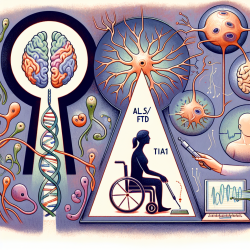Understanding the Role of TIA1 Mutations in ALS/FTD
Amyotrophic lateral sclerosis (ALS) and frontotemporal dementia (FTD) are complex neurodegenerative disorders that have long puzzled researchers and clinicians alike. Recent research has uncovered a significant link between mutations in the T-cell restricted intracellular antigen-1 (TIA1) and the onset of ALS, with or without FTD. This discovery opens new avenues for understanding the disease and improving clinical practice.
Key Findings from the Research
The study titled "Clinical and neuropathological features of ALS/FTD with TIA1 mutations" provides a comprehensive analysis of nine cases with confirmed TIA1 mutations. Here are some key takeaways:
- All nine patients were female, with a wide age range at onset from the late twenties to the eighth decade.
- The clinical presentation was diverse, with symptoms ranging from focal weakness to language impairment.
- Neuropathological examinations revealed widespread TDP-43 proteinopathy, a hallmark of ALS and FTD.
- Distinctive features included increased numbers of lower motor neurons with round eosinophilic and Lewy body-like inclusions.
Implications for Clinical Practice
For practitioners, these findings emphasize the importance of considering genetic factors when diagnosing and treating ALS and FTD. The presence of TIA1 mutations suggests a more nuanced understanding of these conditions, which could lead to more personalized treatment approaches.
Clinicians should be aware of the potential for TIA1 mutations to manifest as either ALS or FTD, or both. This highlights the need for comprehensive assessments that include genetic testing, especially in patients with atypical presentations or a family history of neurodegenerative diseases.
Encouraging Further Research
While this study provides valuable insights, it also underscores the need for further research. Understanding the full spectrum of clinical and neuropathological features associated with TIA1 mutations could lead to the development of targeted therapies. Additionally, exploring the potential gender-specific expression of these mutations could offer new perspectives on disease mechanisms.
Practitioners are encouraged to stay informed about ongoing research in this area and consider participating in studies that explore the genetic underpinnings of ALS and FTD.
Conclusion
The identification of TIA1 mutations as a contributing factor in ALS and FTD represents a significant advancement in our understanding of these diseases. For clinicians, this research highlights the importance of integrating genetic insights into clinical practice to improve patient outcomes. As we continue to unravel the complexities of ALS and FTD, collaboration between researchers and practitioners will be crucial in translating these findings into effective treatments.
To read the original research paper, please follow this link: Clinical and neuropathological features of ALS/FTD with TIA1 mutations.










